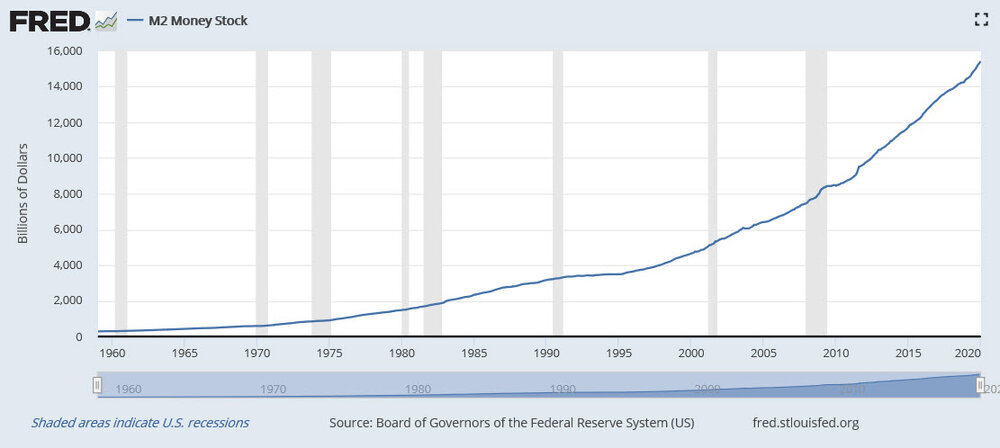DON'T FIGHT THE FED
Matthew Roberts, Certified General Real Estate Appraiser
March 2020
Land prices have exploded over the past forty years or so.
Here is a map from the Lincoln Institute of Land Policy showing the changes in average land values from 1975 to 2015 in each state.
Here is another one. This map shows land values by county, substituting land area for increases in land prices. It is pretty neat. (Try not to get hypnotized.)
Why are land prices in general going up so much? Is it maybe because more Americans are entering into home ownership? More people buying homes might mean higher real estate prices. That would make sense, right? Well, let’s look. Here is the home-ownership rate in the US:
Well, maybe that’s not the answer: the percentage of home-ownership has not made it even close to where it was for most of the 2000s.
Farmland prices are also up.
The previous maps included residential sites, so let’s look at farmland alone. If you talk to farmers who bought farmland forty years ago, you’ll know that their biggest regret is that they didn’t buy more! Here’s a chart from the USDA:
The next chart below, also from the USDA, shows farmland prices since 2005. The 2008 financial crisis barely seems to make a speed bump.
Farmland prices have seen just as dramatic an increase as land in general, from just a couple hundred dollars-per-acre forty years ago to over $3,000 per acre. And that’s just the average. I’m sure you are aware of high-quality tillable ground auctioned in places like Iowa and Illinois going for well over $10,000 an acre. So, why have farmland prices gone up so much? Is it because commodity prices have gone up dramatically, too? Higher commodity (grain) prices might justify paying higher prices for farmland. That makes sense, right? Well let’s look at commodity prices from MacroTrends.net:
Well, it was worth a shot. $3.15 per bushel in 1980 to $3.85 per bushel in 2019 – Not quite the big change we were looking for, is it?
I know what you’re thinking. Real estate is just worth more now, simple as that. It’s worth more to more people and worth more relative to everything, right? What if we compare real estate to gold? Who still uses gold as money, anyway? Surely real estate is worth way more in terms of gold that it used to be. We still use real estate, after all. What if we looked at the ratio of gold prices to real estate prices? Would it be up and to the right, too? Here is a chart showing the number of ounces of gold it would take to buy an average new home in the US since 1975:
There certainly seem to be some fluctuations in this one. But it shows that, in both 1978 and in 2018, it would have taken around 300 ounces of gold to buy the average US home! Don’t believe it? Let’s check. I researched average new home prices and the average price of gold for the years 1978 and 2018. The average new home in 1978 cost around $60,000, equal in 1978 to 311 ounces of gold at $193 per ounce. In 2018 the average new home cost around $384,000, equal in 2018 to 303 ounces of gold at $1,268 per ounce. In terms of gold, real estate prices are the same as they were 40 years ago! It’s enough to make you want to pull your hair out!
So what’s the real reason?
Why, then, are real estate prices so high? In my opinion, it’s the inflation. And I don’t just mean price inflation, I mean the actual definition of inflation – an increase in the money supply. Have you ever heard the adage, “Don’t fight the Fed”? The ‘Fed’ is the Federal Reserve, the central bank of the United States. It has many jobs, but only one tool – printing money. But creating more paper money doesn’t create more stuff (real estate, for instance). It means more currency chasing after the same number of goods (or acres) — and therefore, higher prices.
Money in circulation only comes from one source, the Fed. How much more currency could there be compared to forty years ago, anyway? Here’s a chart of the US money supply since 1959. This is the answer you’ve been looking for about rising prices:
I know correlation doesn’t necessarily prove causation, but all those dollars have to go somewhere. And ask yourself, do you think that, short term, in the current market, will the Fed cut rates or raise rates? Lower rates would mean further money supply inflation. Keep in mind that none of this is any guarantee as to what real estate prices will do.
And hey, this isn’t financial advice. Do your own research. I’m just speculating here. Why do YOU think real estate prices have changed so much over the past forty years? Comment, and let me know!
Be sure to subscribe to our newsletter, if you haven’t already. I may cover more inflation and real estate prices in a future newsletter, if you are interested. Let me know what you think!
If you liked the maps and charts in this newsletter, you’ll like these other interesting links:
Here’s how much housing prices have skyrocketed over the last 50 years in every US state
Here's What A $1 Million Home Looks Like In All 50 States
https://www.buzzfeed.com/emmyf/1-million-home-in-all-50-states








